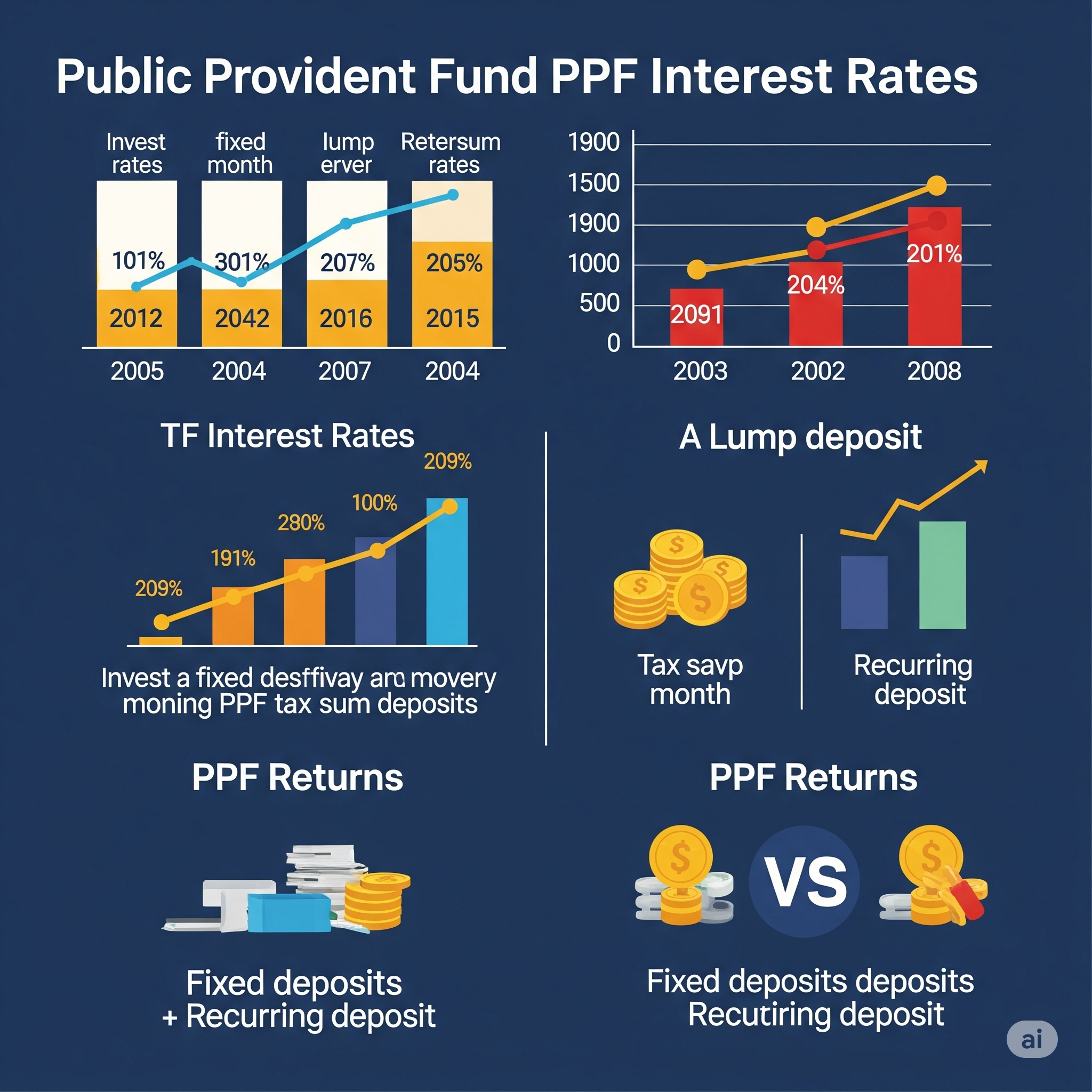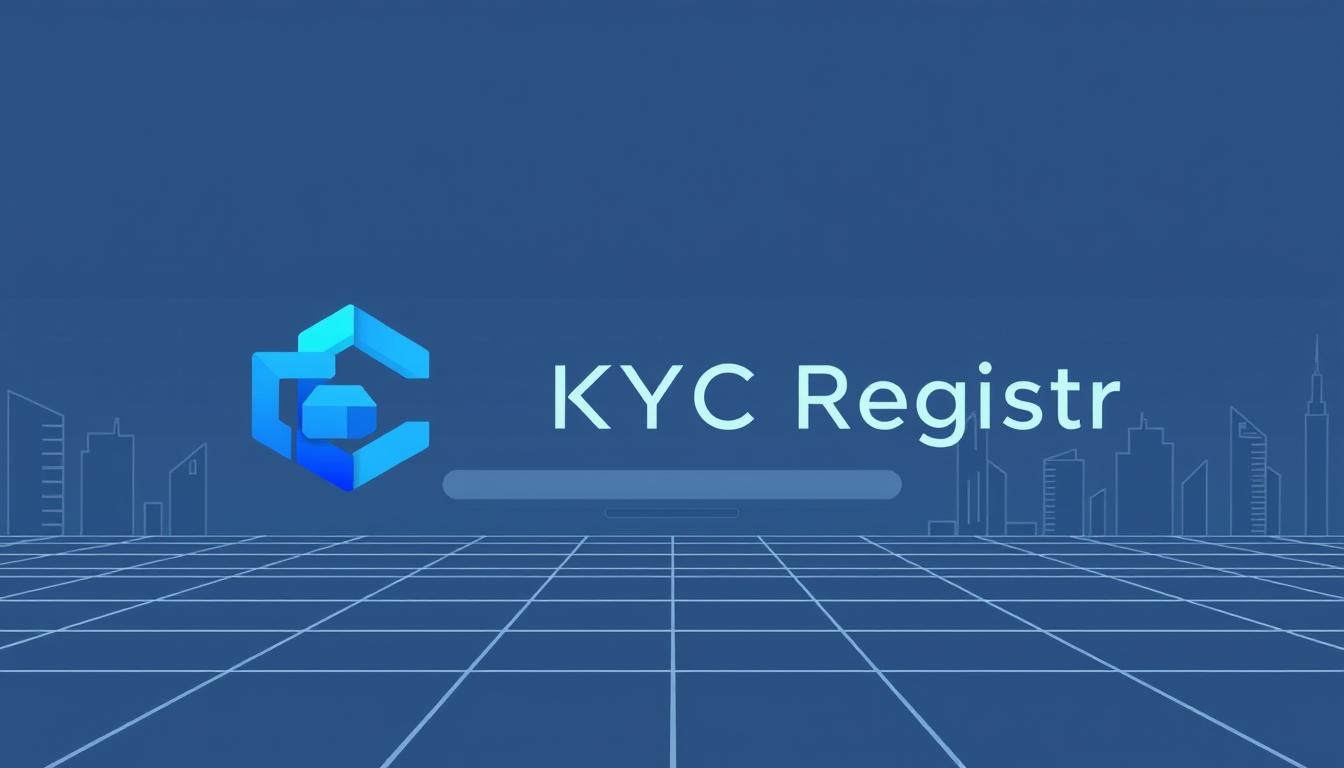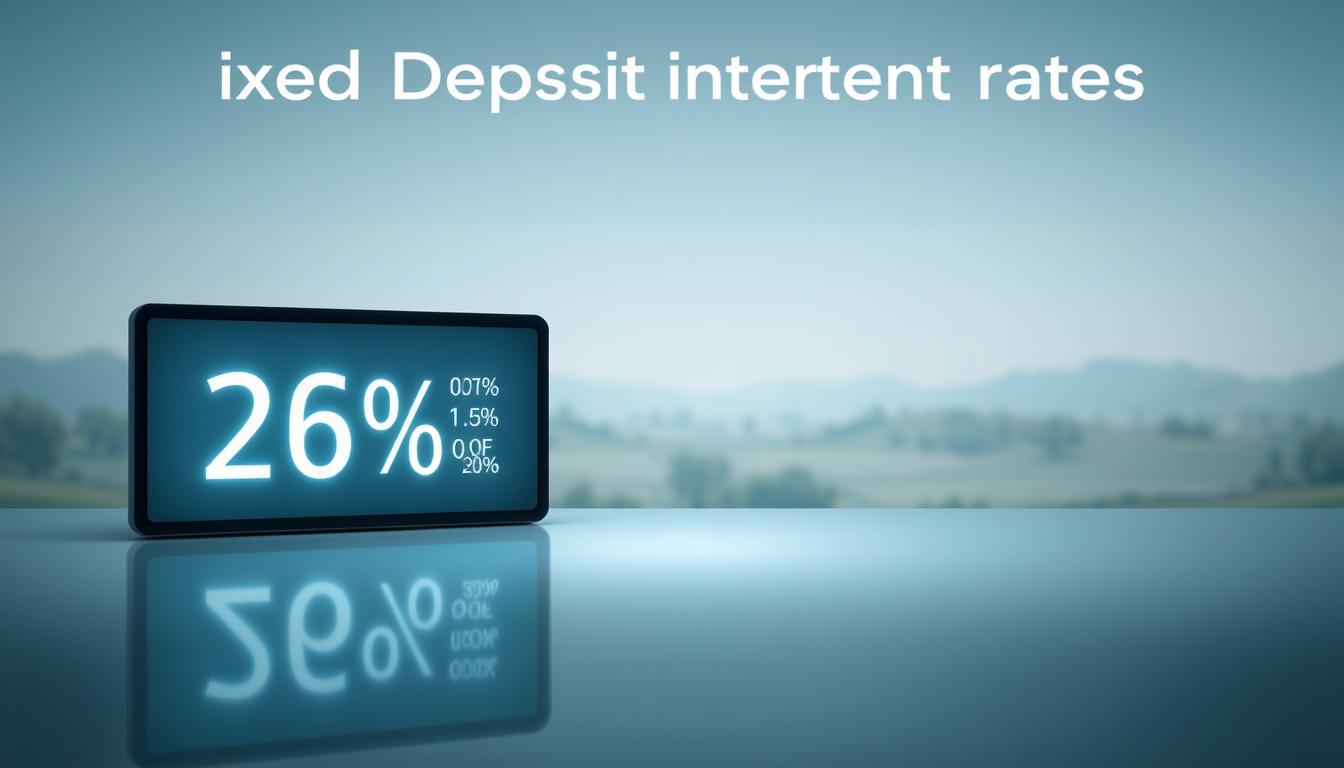In India, fixed deposits remain a highly preferred investment option due to their unique blend of safety and assured returns. When you opt for a fixed deposit, you essentially deposit a lump sum amount with a bank or financial institution for a specified period at a predetermined interest rate.

Banks like ICICI Bank and financial institutions such as Bajaj Finance offer competitive interest rates. For instance, ICICI Bank provides interest rates as high as 7.55% p.a. for senior citizens, while Bajaj Finance offers up to 8.60% p.a. for senior citizens in their FD Max variant.
This article will delve into the world of deposits, exploring the various options available, the latest rates offered by major banks, and how to maximize your returns through strategic planning.
Key Takeaways
- Understanding how fixed deposits work as a financial instrument.
- Exploring the latest interest rates offered by major banks and financial institutions.
- Learning how to maximize your returns on deposits.
- Discovering why fixed deposits are a cornerstone of financial planning for risk-averse investors.
- Understanding the process of opening a fixed deposit account.
What is a Fixed Deposit and How Does It Work?
For those looking to secure their funds, fixed deposits provide a safe and reliable investment avenue. A fixed deposit (FD) is a financial instrument offered by banks, where you deposit a specific amount for a predetermined tenure, earning a fixed interest rate.
Definition and Basic Concept
A fixed deposit is essentially a savings account with a fixed term and interest rate. When you open a fixed deposit account, you agree to keep your money locked in the deposit for a specified period, which can range from a few months to several years. In India, banks like ICICI offer two types of FDs: Traditional Fixed Deposit and Cumulative Fixed Deposit.
In a Traditional Fixed Deposit, the interest amount is credited at regular intervals, such as quarterly or monthly. On the other hand, Cumulative Fixed Deposits involve adding the interest accrued back to the principal amount at quarterly intervals, resulting in a lump sum payout at maturity.
The Working Mechanism of Fixed Deposits
The working mechanism of fixed deposits involves several key aspects. When you open an FD account, you deposit a specific amount with the bank for a predetermined tenure. The bank uses these funds for lending and other banking operations. In return, the bank offers a higher interest rate compared to regular savings accounts, with the rate remaining fixed regardless of market fluctuations.
Interest calculation on fixed deposits in India typically follows either simple interest (for non-cumulative FDs) or compound interest (for cumulative FDs) methods, with compounding usually done quarterly. At maturity, you receive your principal amount along with the accrued interest, or you can choose to reinvest the amount for another term.
| Type of FD | Interest Payout | Compounding Frequency |
|---|---|---|
| Traditional Fixed Deposit | Quarterly or Monthly | Quarterly |
| Cumulative Fixed Deposit | At Maturity | Quarterly |
Banks in India offer various payout options for the interest earned, allowing you to choose based on your liquidity requirements. Understanding these mechanisms can help you make informed decisions about your investments.
Benefits of Investing in Fixed Deposits
The benefits of investing in fixed deposits are multifaceted, catering to various financial goals. Investors in India can capitalize on the flexibility and security offered by fixed deposits.
Guaranteed Returns and Safety
Fixed deposits are known for their guaranteed returns and safety, making them an attractive option for risk-averse investors. Indian banks and NBFCs offer fixed deposits with tenures ranging from 7 days to 10 years, ensuring that investors can align their investments with specific financial goals while maintaining better returns than savings accounts.
Liquidity Options
Fixed deposits provide liquidity options that cater to different financial needs. Short-term fixed deposits (7 days to 1 year) are ideal for parking temporary surplus funds or meeting near-term financial objectives. Medium-term deposits (1-3 years) strike a balance between liquidity and returns, making them suitable for goals like education funds or major purchases.
Flexible Tenure Options
The flexible tenure options available with fixed deposits allow investors to plan their investments according to their financial goals. Long-term fixed deposits (3-10 years) typically offer the highest interest rates and are perfect for retirement planning or creating a corpus for long-term goals. Many financial institutions in India, like Bajaj Finance Digital FD, offer special tenure options (such as 18, 22, 33, or 44 months) with higher interest rates, enabling investors to maximize returns by strategically choosing these specific periods.
By understanding the benefits and flexibility of fixed deposits, investors can make informed decisions that align with their financial objectives, ensuring a secure financial future.
Types of Fixed Deposit Accounts in India
Fixed deposit accounts in India come in various forms, catering to different financial goals and investor preferences. The diverse range of fixed deposit accounts allows investors to choose the one that best suits their needs.
Regular Fixed Deposits
Regular fixed deposits are the most common type of fixed deposit account. They offer a fixed interest rate for a specified tenure, providing a low-risk investment option. Investors can choose the tenure and interest payout frequency, making it a flexible option.
Tax Saver Fixed Deposits
Tax saver fixed deposits are designed to help investors save on taxes while earning interest. These deposits have a lock-in period of five years and offer tax deductions under Section 80C of the Income Tax Act. They are an attractive option for those looking to reduce their taxable income.
Cumulative Fixed Deposits
Cumulative fixed deposits are a type of fixed deposit where the interest is compounded quarterly and paid out at maturity. This option is ideal for investors who want to maximize their returns over the tenure of the deposit.
Non-Cumulative Fixed Deposits
Non-cumulative fixed deposits provide periodic interest payouts, offering a regular income stream. Investors can choose the frequency of interest payouts, such as monthly, quarterly, or annually. This type of fixed deposit is particularly beneficial for retirees or those seeking regular income.
| Type of Fixed Deposit | Interest Payout Frequency | Benefits |
|---|---|---|
| Regular Fixed Deposits | Monthly, Quarterly | Flexible tenure and interest payout options |
| Tax Saver Fixed Deposits | At Maturity | Tax deductions under Section 80C |
| Cumulative Fixed Deposits | At Maturity | Compounded interest for higher returns |
| Non-Cumulative Fixed Deposits | Monthly, Quarterly, Annually | Regular income stream |
Current Fixed Deposit Interest Rates in India

Currently, the fixed deposit landscape in India is characterized by competitive interest rates offered by various banks and NBFCs. Investors, particularly senior citizens, are benefiting from these rates.
Interest Rates for General Citizens
General citizens in India can avail of fixed deposit interest rates that vary across different banks and financial institutions. The rates are influenced by factors such as the deposit amount and tenure. For instance, ICICI Bank offers competitive rates for fixed deposits.
Special Rates for Senior Citizens
Senior citizens, typically individuals aged 60 years and above, enjoy preferential interest rates on fixed deposits, usually 0.25% to 0.75% higher than the standard rates. Currently, major banks like ICICI Bank offer senior citizen FD rates as high as 7.55% p.a. NBFCs like Bajaj Finance offer even more attractive rates up to 8.60% p.a. on special FD variants for senior citizens.
The additional interest benefit for senior citizens applies across all tenure options, making fixed deposits an attractive and safe investment avenue for retirement planning. Some financial institutions also offer super senior citizen categories with even higher interest rate benefits.
Factors Affecting Fixed Deposit Interest Rates
The determination of fixed deposit interest rates involves a complex interplay of several critical factors.
Deposit Amount and Tenure
The interest rate offered on a fixed deposit can vary based on the deposit amount and the tenure chosen. Generally, higher deposit amounts and longer tenures attract higher interest rates. Banks often provide different interest rates for different slabs of deposit amounts, incentivizing larger deposits. Moreover, the tenure of the deposit plays a significant role, with longer tenures typically earning higher interest rates due to the longer commitment of funds.
- Higher deposit amounts often qualify for higher interest rates.
- Longer tenures are usually rewarded with higher returns.
Economic Factors and RBI Policies
Economic factors and the Reserve Bank of India’s (RBI) monetary policy decisions significantly influence fixed deposit interest rates. The RBI’s adjustments to the repo rate have a cascading effect on the interest rates offered by banks on fixed deposits. During periods of high inflation, the RBI may increase policy rates to curb inflation, leading to higher fixed deposit interest rates. Conversely, during economic slowdowns, lower interest rates may be implemented to stimulate growth.
- Economic growth projections, which can lead to changes in interest rates to either stimulate or slow down the economy.
- The liquidity position in the banking system, with banks offering higher rates during periods of tight liquidity to attract deposits.
- Global economic factors, such as international interest rate trends and foreign investment flows, which indirectly influence domestic fixed deposit rates.
How to Open a Fixed Deposit Account

To secure your funds, you need to understand the simple steps involved in opening a fixed deposit account. The process is designed to be straightforward and efficient, allowing you to easily manage your investments online.
Online Application Process
The online application process for a fixed deposit is user-friendly and can be completed in a few steps. First, you need to log in to your bank‘s online banking portal or mobile app. Then, navigate to the fixed deposit section and fill out the application form with the required details, including the deposit amount and tenure. After submitting the form, you will need to confirm the details and complete the payment. Upon successful completion, you will receive a confirmation, and your fixed deposit account will be activated.
Documents Required for Fixed Deposit
To open a fixed deposit account, you need to fulfill the Know Your Customer (KYC) requirements by providing valid identity and address proofs. Acceptable documents include Aadhaar card, passport, voter ID card, driving license, or a letter from the National Population Register. While a PAN card is no longer considered a valid proof of identity, it is still mandatory for deposits exceeding ₹50,000 to comply with tax regulations. For existing customers with KYC-compliant accounts, most banks offer a simplified process requiring minimal or no additional documentation.
For Non-Resident Indians (NRIs), additional documents such as passport copies with visa stamps, overseas address proof, and local Indian contact details are required when opening NRE or NRO fixed deposits. Ensuring that you have all the necessary documents ready will make the process smoother and faster.
Fixed Deposit Calculators: Planning Your Investment

Planning your investment with a fixed deposit calculator is a smart move for securing your financial future. In India, fixed deposits are a popular investment option due to their guaranteed returns and safety.
How to Use FD Calculators
Using a fixed deposit calculator is straightforward. You need to input the principal amount, interest rate, and tenure. The calculator will then provide you with the maturity amount, helping you plan your investment.
The calculator takes into account the compounding frequency, which is typically quarterly in Indian banks. This means that the interest is compounded every quarter, resulting in a higher effective annual yield.
Calculating Returns on Your Investment
For cumulative fixed deposits, returns are calculated using the compound interest formula: A = P(1 + r/n)^(nt), where A is the maturity amount, P is the principal, r is the annual interest rate, n is the compounding frequency per year, and t is the time in years.
For instance, with quarterly compounding, a ₹1,00,000 deposit at 7% for 5 years would grow to approximately ₹1,41,060, yielding an interest of ₹41,060. For non-cumulative fixed deposits, the simple interest formula is used: I = P × r × t.
When comparing fixed deposits across different banks, it’s essential to consider the post-tax returns rather than just the advertised rates, especially for investors in higher tax brackets. The effective annual yield of a fixed deposit can be higher than the stated rate due to compounding.
Understanding Fixed Deposit Taxation in India
Investing in fixed deposits in India comes with tax implications that every investor should be aware of. The tax rules associated with fixed deposits can significantly impact the overall returns on investment.
TDS on Fixed Deposit Interest
The interest earned on fixed deposits is subject to Tax Deducted at Source (TDS). If the interest earned exceeds the threshold limit, the bank deducts TDS before crediting the interest to the investor’s account. For instance, if the total interest earned in a financial year exceeds ₹40,000 (₹50,000 for senior citizens), TDS is applicable.
It’s essential to note that TDS is not a tax but an advance payment of the tax liability. Investors can claim credit for the TDS while filing their income tax returns.
Tax Exemptions and Deductions
Tax Saver Fixed Deposits offer tax deductions up to ₹1.5 lakhs under Section 80C of the Income Tax Act, 1961. This makes them an attractive option for tax-conscious investors. However, it’s crucial to understand that while the principal amount invested in Tax Saver FDs qualifies for tax deduction, the interest earned remains fully taxable as per the investor’s income tax slab rate.
| Investor Category | Basic Exemption Limit | Taxability of FD Interest |
|---|---|---|
| General Citizens | ₹2.5 lakhs | Taxable |
| Senior Citizens | ₹3 lakhs | Taxable, but higher exemption limit |
| Super Senior Citizens | ₹5 lakhs | Taxable, with the highest exemption limit |
For individuals with no or low taxable income, especially senior citizens relying on FD interest, the basic exemption limit can effectively make their interest earnings tax-free. However, under the new tax regime introduced in 2020, the Section 80C deduction is not available, affecting the tax advantage of Tax Saver FDs for those opting for the new regime.
Fixed Deposit Premature Withdrawal and Penalties
When investing in a fixed deposit, understanding the implications of premature withdrawal is crucial. Investors should be aware of the rules and penalties associated with early withdrawal to make informed decisions.
Rules for Premature Withdrawal
In India, banks typically impose penalty charges for premature withdrawal of fixed deposits. The penalty can range from 0.5% to 1% reduction in the applicable interest rate, depending on the original tenure of the deposit. For instance, deposits with an original tenure of less than 1 year may incur a 0.50% penalty, while those with a tenure of 1 year or more but less than 5 years may face a 1.00% penalty.
The penalty is usually applied by recalculating the interest rate at a lower rate for the period the deposit has been held. In some cases, if the deposit is held for less than the minimum required tenure (typically 7 days), banks may not pay any interest on premature withdrawal.
Penalty Charges and Their Impact
The impact of penalty charges can be significant, especially for large deposits or those with substantial interest rate differentials between different tenure brackets. However, some premium banking relationships or special deposit schemes may offer reduced or waived premature withdrawal penalties as part of their benefits package.
Investors should carefully review the terms and conditions of their fixed deposit before making a premature withdrawal, considering the potential charges and their impact on the overall returns.
Fixed Deposit Laddering Strategy
A fixed deposit laddering strategy is a savvy investment approach that involves distributing your investments across multiple fixed deposits with varying tenure periods. This method allows investors to strike a balance between maximizing returns and maintaining liquidity.
What is FD Laddering?
FD laddering involves spreading your fixed deposit investments across different tenure periods. Instead of investing a lump sum in a single fixed deposit, you divide your investment into multiple fixed deposits with staggered maturity dates. For instance, you could invest ₹1 lakh in five different fixed deposits with tenures of 1, 2, 3, 4, and 5 years, respectively.
Benefits of Implementing an FD Ladder
Implementing a fixed deposit laddering strategy offers several benefits to investors in India. Some of the key advantages include:
- Enhanced Liquidity Management: By having multiple fixed deposits with staggered maturity dates, you can ensure regular access to your funds without having to break a large deposit prematurely.
- Interest Rate Optimization: Spreading investments across different tenures allows you to benefit from higher interest rates for longer tenures while maintaining flexibility.
- Protection Against Interest Rate Fluctuations: FD laddering helps mitigate the impact of interest rate changes by not committing all your funds at a single rate.
- Balanced Risk and Return: This strategy offers a balanced approach to risk and return, making it particularly valuable for conservative investors.
- Disciplined Investment Approach: FD laddering promotes a disciplined investment strategy with automatic reinvestment opportunities, helping investors maintain their financial goals.
Loan Against Fixed Deposit: Accessing Funds in Emergencies

Fixed deposits are not just a safe investment option but can also serve as collateral for loans in times of need. This feature makes them an attractive financial product for individuals who want to maintain liquidity while earning interest on their savings.
How Overdraft Against FD Works
An overdraft facility against a fixed deposit allows you to borrow money from the bank using your FD as collateral. The process is straightforward: you pledge your FD to the bank, and in return, you are offered a loan amount that is a percentage of the FD’s value. The loan amount can then be used as needed.
Interest Rates and Eligibility
The interest rates on loans against fixed deposits in India are typically 1-2% higher than the FD’s interest rate. For instance, if your FD earns 7% interest, the loan against it might be charged at 8-9%. This rate is significantly lower than personal loan rates or credit card interest rates, making it a cost-effective borrowing option. To be eligible for an overdraft facility against an FD, you need to have an active fixed deposit with the bank, and the FD should not be under any lien or encumbrance.
Most banks in India offer loan amounts up to 90% of the FD value. The loan tenure is typically linked to the remaining tenure of the fixed deposit, with the loan needing to be repaid before or at the time of the FD’s maturity. This feature provides flexibility and helps in managing financial emergencies without having to break your FD and lose out on interest.
Comparing Fixed Deposits with Other Investment Options
When considering investment options in India, it’s essential to compare fixed deposits with other available choices. This comparison helps investors make informed decisions based on their financial goals, risk appetite, and liquidity needs.
FD vs. Recurring Deposits
Fixed Deposits (FDs) and Recurring Deposits (RDs) are both popular bank deposit schemes. While FDs involve depositing a lump sum for a fixed tenure, RDs require regular monthly deposits. FDs offer higher interest rates for lump sum deposits, making them suitable for those with surplus funds. In contrast, RDs are ideal for individuals who want to save regularly.
FD vs. Mutual Funds
FDs and Mutual Funds (MFs) cater to different investment objectives. FDs provide fixed, guaranteed returns, whereas MFs offer potentially higher returns through diversified portfolios but come with market risks. Investors seeking stable, low-risk returns often prefer FDs, while those willing to take on more risk for higher returns might opt for MFs.
FD vs. Public Provident Fund
The Public Provident Fund (PPF) and FDs are both long-term investment options with tax benefits. PPF offers tax-free returns under the EEE regime, whereas only the principal investment in Tax Saver FDs qualifies for tax deduction. PPF has a fixed 15-year tenure and allows partial withdrawals after 7 years, making it less liquid than FDs, which can be withdrawn prematurely with a penalty.
Conclusion
Fixed deposits have emerged as a cornerstone of investment strategies in India, providing assured returns and financial security. They remain a preferred choice for a wide range of investors due to their perfect balance of safety, predictable returns, and flexibility.
For risk-averse investors, particularly senior citizens and those with short to medium-term financial goals, fixed deposits provide peace of mind through guaranteed interest that is insulated from market volatility. The diverse range of fixed deposit options available in India allows investors to tailor their deposit to specific financial objectives.
Strategic approaches like FD laddering and utilizing facilities such as loans against fixed deposits can enhance the utility of fixed deposits beyond simple interest earnings. While fixed deposits may not offer inflation-beating returns in all economic scenarios, they serve as an essential component of a well-diversified investment portfolio, providing stability and liquidity alongside potentially higher-return but riskier investment options.
As interest rates continue to evolve with economic conditions in India, staying informed about the latest rates and features across different banks and financial institutions is crucial for maximizing your fixed deposit investments.









